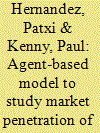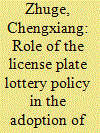| Srl | Item |
| 1 |
ID:
105798


|
|
|
|
|
| Publication |
2011.
|
| Summary/Abstract |
A spatially explicit agent-based vehicle consumer choice model is developed to explore sensitivities and nonlinear interactions between various potential influences on plug-in hybrid vehicle (PHEV) market penetration. The model accounts for spatial and social effects (including threshold effects, homophily, and conformity) and media influences. Preliminary simulations demonstrate how such a model could be used to identify nonlinear interactions among potential leverage points, inform policies affecting PHEV market penetration, and help identify future data collection necessary to more accurately model the system. We examine sensitivity of the model to gasoline prices, to accuracy in estimation of fuel costs, to agent willingness to adopt the PHEV technology, to PHEV purchase price and rebates, to PHEV battery range, and to heuristic values related to gasoline usage. Our simulations indicate that PHEV market penetration could be enhanced significantly by providing consumers with ready estimates of expected lifetime fuel costs associated with different vehicles (e.g., on vehicle stickers), and that increases in gasoline prices could nonlinearly magnify the impact on fleet efficiency. We also infer that a potential synergy from a gasoline tax with proceeds is used to fund research into longer-range lower-cost PHEV batteries.
|
|
|
|
|
|
|
|
|
|
|
|
|
|
|
|
| 2 |
ID:
176653


|
|
|
|
|
| Summary/Abstract |
Policy is an influential factor to the purchase and usage of Electric Vehicles (EVs). This paper is focused on the license plate lottery policy, a typical vehicle purchase restriction in Beijing, China. An agent-based spatial integrated urban model, SelfSim-EV, is employed to investigate how the policy may influence the uptake of EVs over time at the individual level. Two types of “what-if” scenario were set up to explore how the methods to allocate the vehicle purchase permits and the number of permits might influence the EV market expansion from 2016 to 2020. The results suggested that 1) both the allocation methods and the number of purchase permits could heavily influence the uptake of EVs and further its impacts on vehicular emissions, energy consumption and urban infrastructures; 2) compared to the baseline, both scenarios got significantly different spatial distributions of vehicle owners, transport facilities, vehicular emissions and charging demand at the multiple resolutions; 3) SelfSim-EV was found as a useful tool to quantify the nonlinear relationships between the increase of EV purchasers and the demand for transport facilities and electricity, and also to capture some unexpected results coming out from the interactions in the complex dynamic urban system.
|
|
|
|
|
|
|
|
|
|
|
|
|
|
|
|
| 3 |
ID:
140243


|
|
|
|
|
| Summary/Abstract |
This paper highlights the evolution of the relations between highlanders and lowlanders that took place in one of the Mekong's riparian eastern territories in Ratanakiri province. It contributes to knowledge and debate on the impacts of landscape transformation and dispossession on indigenous peoples and their culture in upland Cambodia. The first section considers the legacy of the past and emphasises successive attempts of resistance. It contributes to an understanding of why highlanders opted to live in a forest milieu, not isolated from outsiders but careful to maintain some distance. The second section delineates the evolution of the interactions between natural ecosystems and social ecosystems in the changing tributary region. The last section documents major changes that have recently occurred under the guise of development. It questions the remaining possibilities for indigenous people to continue living with dignity in a shrunken territory in the present socio-political environment. The conclusion proposes research orientations focusing on some neglected dimensions of indigenous cultures dealing with new forms of resistances.
|
|
|
|
|
|
|
|
|
|
|
|
|
|
|
|